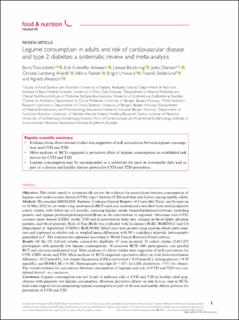| dc.description.abstract | Objectives: This study aimed to systematically review the evidence for associations between consumption of legumes and cardiovascular disease (CVD), type 2 diabetes (T2D) and their risk factors among healthy adults.
Methods: We searched MEDLINE, Embase, Cochrane Central Register of Controlled Trials, and Scopus up to 16 May 2022 for ≥4 weeks long randomized (RCT) and non-randomized controlled trials and prospective cohort studies with follow-up ≥12 months, assessing legume intake (beans/lentils/peas/soybeans, excluding peanuts and legume-products/protein/powder/flour) as the intervention or exposure. Outcomes were CVD, coronary heart disease (CHD), stroke, T2D and in intervention trials only: changes in blood lipids, glycemic markers, and blood pressure. Risk of bias (RoB) was evaluated with Cochrane’s RoB2, ROBINS-I, and US Department of Agriculture (USDA)’s RoB-NObS. Effect sizes were pooled using random-effects meta-analyses and expressed as relative risk or weighed mean differences with 95% confidence intervals, heterogeneity quantified as I2. The evidence was appraised according to World Cancer Research Fund’s criteria.
Results: Of the 181 full-text articles assessed for eligibility, 47 were included: 31 cohort studies (2,081,432 participants with generally low legume consumption), 14 crossover RCTs (448 participants), one parallel RCT and one non-randomized trial. Meta-analyses of cohort studies were suggestive of null associations for CVD, CHD, stroke and T2D. Meta-analyses of RCTs suggested a protective effect on total cholesterol (mean difference −0.22 mmol/L), low density lipoprotein (LDL)-cholesterol (−0.19 mmol/L), fasting glucose (−0.19 mmol/L), and HOMA-IR (−0.30). Heterogeneity was high (I2 = 52% for LDL-cholesterol, >75% for others). The overall evidence for associations between consumption of legumes and risk of CVD and T2D was considered limited – no conclusion.
Conclusion: Legume consumption was not found to influence risk of CVD and T2D in healthy adult populations with generally low legume consumption. However, protective effects on risk factors, seen in RCTs, lend some support for recommending legume consumption as part of diverse and healthy dietary patterns for prevention of CVD and T2D. | en_US |

